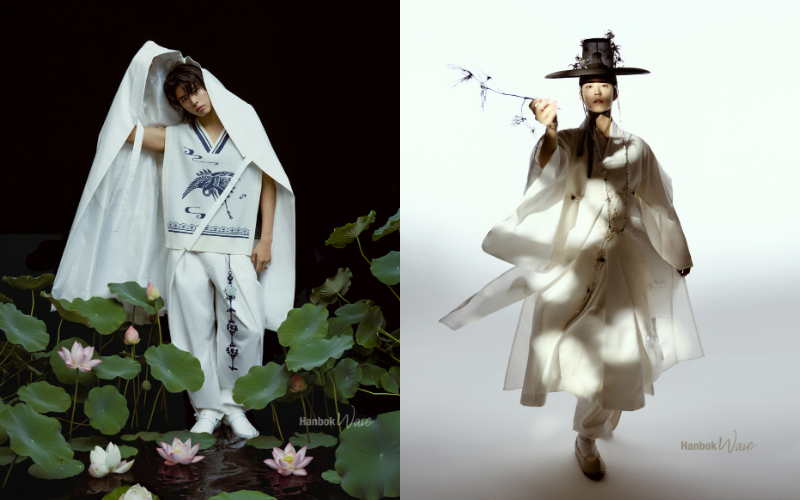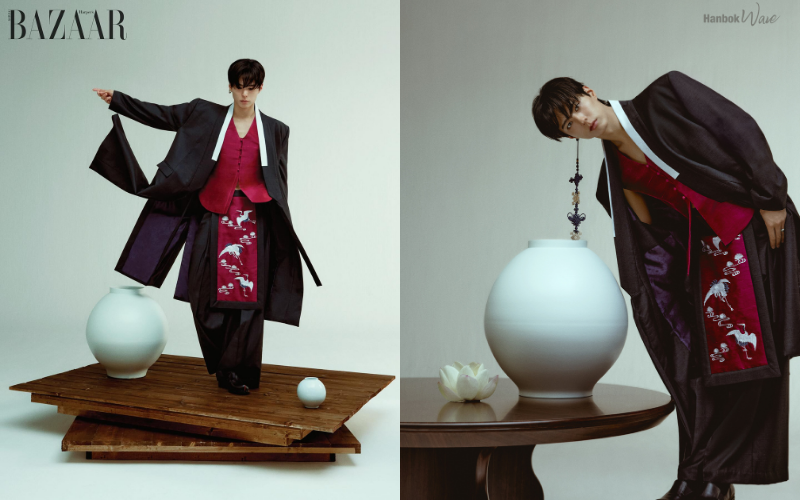[INTERVIEW] Korean designer shares Hanbok designs for Park Bo Gum’s Hanbok Wave 2025 project
2025-10-22Launched in 2020, Hanbok Wave 2025 continues to share the beauty of Hanbok with the world while celebrating the creativity of local designers. Organized by the Ministry of Culture, Sports and Tourism and the Korea Craft & Design Foundation, the project bridges centuries of artistry with modern innovation, proving that Hanbok is not a relic of the past but a living expression of Korean identity and craftsmanship.
This year’s ambassador, Park Bo-gum, the first male actor to represent the campaign, perfectly embodies its spirit of harmony and renewal. On October 6, a special video shoot featuring the actor was showcased on large billboards across major global cities, including New York’s Times Square, Seoul’s Myeongdong Shinsegae Square, Shinjuku in Tokyo, Citadium in Rue de Caumartin in Paris and Piazza del Duomo in Milan.
Previous ambassadors include Kim Yuna (2022), the former Olympic figure skating champion, Bae Suzy (2023), actress and singer, and Kim Tae-ri (2024), acclaimed actress.
Narae Kang is the designer and founder of the Korean contemporary Hanbok brand MUREUT (MOOROOTS), established in 2017. MUREUT aims to modernize Hanbok and bring it into everyday life. The name “Movement from the Roots” reflects both a sense of evolution from tradition and, in Korean, the word Mureut carries the meaning of “generally” or “as it is.” This dual meaning captures MUREUT’s philosophy that hanbok should not be limited to special occasions, but rather become a garment people can wear naturally in everyday life. Guided by this belief, MUREUT creates designs that blend seamlessly with modern wardrobes; comfortable, versatile, and effortlessly wearable.
Below are excerpts from an email interview with Narae Kang conducted on Oct 13-21, in which the designer discusses MUREUT’s Hanbok creations for Park Bo Gum as part of the Hanbok Wave campaign.
1. How do you reinterpret Hanbok to make it more practical and appealing to modern audiences?
When we use traditional Hanbok fabrics, we retain contemporary silhouettes; and when we adopt Hanbok silhouettes, we use fabrics and construction methods that make the pieces more practical and easy to coordinate. We strive to create “Hanbok that is easy to wear, and easy to love.” Through reinterpreting tradition and sharing our experience, we hope to elevate the value of Hanbok in the modern world.

2. What was your main inspiration behind the Hanboks created for the actor Park Bo Gum?
I wanted to highlight Park Bo Gum’s pure and upright image while adding a modern sensibility. In Korea, that sense of virtue and refinement is traditionally represented by the word Seonbi (a classical scholar). The crane, a symbol of the Seonbi’s spirit, became the central motif of the design. From there, we developed the concept “Modern Seonbi,” a balance of integrity and sophistication. The collection combines traditional symbolism with sleek modern tailoring, capturing a look that feels both dignified and contemporary.
3. What symbolic meanings are embedded in the colors or embroidery patterns used?
As mentioned earlier, the key motif is the crane, which symbolizes nobility, integrity, and purity in Korean tradition. The base tone of the Hanbok is white, a color long associated with the scholar’s spirit in Korean culture. In addition, one of the outfits draws inspiration from the traditional Korean artifact Cheonghwa Baekja (Blue and White Porcelain), combining white and blue tones to express calmness and elegance. Across the three looks worn by Park Bo Gum, all garments feature crane patterns, some through embroidery, others through jacquard knit techniques. For the suit worn at Music Bank in Lisbon, traditional paeseul decorations were reinterpreted through embroidered crane motifs. For the Harper’s Bazaar cover look, cranes were expressed through knitted patterns. The traditional Hanbok piece featured delicate white-on-white crane embroidery to capture the serene spirit of the Seonbi.
4. Were the designs customized to reflect the actor’s or the project’s theme?
Yes. The Hanbok Wave project requested three design moods; Traditional Hanbok, Artwear, and Dailywear. For the Traditional Hanbok line, I focused on the elegance and grace of heritage silhouettes. The Artwear line was designed for stage performance, emphasizing bold structure and charisma, and the Dailywear line expressed comfort and approachability with softer colors and materials. Park Bo Gum deeply understood these concepts and personally requested to wear the Artwear Hanbok for his performance at Music Bank in Lisbon, which was truly meaningful for me as a designer.

5. Could you share more about the materials, dyeing, or sewing techniques used in these Hanboks?
Each line uses distinct materials and construction methods. For the Traditional Hanbok, we used silk and employed traditional Korean sewing techniques, which differ greatly from Western tailoring methods. Preserving this craft is an essential part of my responsibility as a Hanbok designer. For the Artwear and Dailywear lines, we mixed Hanbok sewing techniques with modern garment construction. We also incorporated traditional “yeonbong maedeup” (button-like knots) throughout the pieces to add intricate detail.
6. What do you like about Hanbok?
Unlike Western fashion, which often molds the body to fit the garment (as with corsets), Hanbok is designed to let the garment naturally adapt to the wearer’s body. This philosophy reflects the Korean view of harmony with nature, accepting and expressing things as they are. That organic beauty is what I love most about Hanbok.
7. What was the most rewarding moment during this project?
Every stage brought challenges and small victories, but the most rewarding moment was when Park Bo Gum’s photoshoot was unveiled globally. It felt like all our hard work had been recognized, and it became an unforgettable opportunity to introduce both Hanbok and MUREUT to audiences around the world.
8. What impact do you think projects such as Hanbok Wave can have on international awareness and appreciation of Hanbok?
I believe it’s one of the most ideal ways to promote Hanbok; to have Korea’s beloved stars share the beauty of our traditional attire with the world. When internationally recognized artists proudly wear Hanbok, they help people across cultures understand, appreciate, and celebrate it as a living part of Korean heritage.
Amid the Hanbok Wave project, MUREUT reveals its creative vision for blending tradition and modernity in Hanbok.
How about this article?
- Like0
- Support0
- Amazing2
- Sad0
- Curious0
- Insightful0


